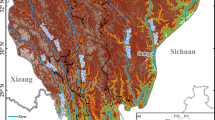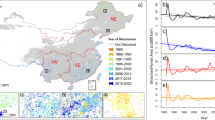Abstract
Monitoring forest disturbances is important for understanding changes in ecosystems. The 1986 Typhoon Vera was a serious disturbance that severely impacted the forest ecosystems of Changbai Mountain National Nature Reserve. Although the typhoon disturbance occurred more than two decades ago, the effects of the typhoon still remain within the study area. Few studies have focused on mapping and assessing disturbances across broad spatial and temporal scales. For this study, we first generated a map of forest composition prior to the typhoon disturbance, which served as a baseline data for the extraction of disturbed area. Then, the Disturbance Index (DI) method was tested for mapping the extent and magnitude of disturbance in the study area by applying a Tasseled Cap transformation to the Landsat imagery. The Landsat-based DI method estimated that an area of 13,764.78 ha of forest was disturbed by the typhoon. Based on visual assessments, these results correspond closely with the reference map derived from ground surveys. These results also revealed the influence of local topographic features on the distribution of windthrow areas. Windthrow areas were more pronounced in areas with elevations ranging from 1,000 to 2,000 m, slopes of less than 10 degrees, and southwestern to northwestern aspects. In addition, the relatively long (25 years) post-typhoon recovery period assessed by this study provided a more comprehensive analysis of the dynamics of forest recovery processes over time. Windthrow areas did not recover immediately after the typhoon, likely due to forest management practices enacted at the time. So far, forest recovery has proceeded more rapidly at elevations below 1,400 m, particularly on western slopes within the study area. Finally, a time series of DI values within the study period suggests a secondary disturbance may have occurred between 2000 and 2001.
Similar content being viewed by others
References
Adler-Golden S, Berk A, Bernstein LS, et al. (1998) FLAASH, a MODTRAN4 atmospheric correction package for hyperspectral data retrievals and simulations, Pasadena, California: JPL Pub. pp 1–9.
Beurs KM, Townsend PA (2008) Estimating the effect of gypsy moth defoliation using MODIS. Remote Sensing of Environment 112: 3983–3990. DOI: 10.1016/j.rse.2008.07.008
Chen GS, Tian HQ, Huang CQ, et al. (2013) Integrating a process-based ecosystem model with Landsat imagery to assess impacts of forest disturbance on terrestrial carbon dynamics: Case studies in Alabama and Mississippi. Journal of Geophysical Research: Biogeosciences 118: 1208–1224. DOI: 10.1002/jgrg.20098
Chen J, Sun LQ (2010) Using MODIS EVI to detect vegetation damage caused by the 2008 ice and snow storms in south China. Journal of Geophysical Research: Biogeosciences 115(4). DOI: 10.1029/2009JG001246
Chen XX, Vogelmann JE, Rollins M et al. (2011) Detecting postfire burn severity and vegetation recovery using multitemporal remote sensing spectral indices and field-collected composite burn index data in a ponderosa pine forest. International Journal of Remote Sensing 32: 7905–7927. DOI: 10.1080/01431161.2010.524678
David RF, Bqqse R (1992) Patterns of forest damage resulting from catastrophic wind in central New England, USA. Journal of Ecology 80: 79–98. DOI: 10.2307/2261065
Dixon RK, Brow S, Houghton RA et al. (1994) Caron Pools and Flux of Global Forest Ecosystems. Science 263: 185–190. DOI: 10.1126/science.263.5144.185
Eshleman KN, McNeil BE, Townsend PA (2009) Validation of a remote sensing based index of forest disturbance using streamwater nitrogen data. Ecological Indicators 9: 476–484. DOI: 10.1016/j.ecolind.2008.07.005
Griffiths P, Kuemmerle T, Baumann M, et al. (2013) Forest disturbances, forest recovery, and changes in forest types across the Carpathian ecoregion from 1985 to 2010 based on Landsat image composites. Remote Sensing of Environment. DOI: 10.1016/j.rse.2013.04.022
Guo D, Zhang HY, Hou GL, et al. (2014) Topographic Controls on Alpine Treeline Patterns on Changbai Mountain, China. Journal of Mountain Science 11: 429–441. DOI: 10.1007/s11629-013-2706-5
Hais M, Jonášová M, Langhammer J, et al. (2009) Comparison of two types of forest disturbance using multitemporal Landsat TM/ETM+ imagery and field vegetation data. Remote Sensing of Environment 113: 835–845. DOI: 10.1016/j.rse.2008.12.012
Healey SP, Cohen WB, Yang ZQ, et al. (2005) Comparison of tasseled cap-based Landsat data structures for use in forest disturbance detection. Remote Sensing of Environment 97: 301–310. DOI: 10.1016/j.rse.2005.05.009
Hong Kong Royal Observatory (1987) Meteorological Result 1986: Part III-Tropical Cyclone Summaries. p 10.
Hou GL, Zhang HY, Wang YQ (2011) Vegetation dynamics and its relationship with climatic factors in the Changbai Mountain Natural Reserve. Journal of Mountain Science 8: 865–875. DOI: 10.1007/s11629-011-2206-4
Hou XY, Han JX (1997) The restoration and protection of the wind disaster-interfered area on the western slopes of the Changbai Mountain. Journal of Natural Resources 12: 29–34. (In Chinese)
Huang C, Wylie B, Yang L, et al. (2002) Derivation of a tasselled cap transformation based on Landsat 7 at-satellite reflectance. International Journal of Remote Sensing 23: 1741–1748. DOI: 10.1080/01431160110106113
Hobbs RJ, Huenneke LF (1992) Disturbance, diversity, and invasion: implications for conservation. Conservation Biology 6: 324–337. DOI: 10.1046/j.1523-1739.1992.06030324.x
Imbert D, Labbé P, Rousteau A (1996) Hurricane damage and forest structure in Guadeloupe, French West Indies. Journal of Tropical Ecology 12: 663–680. DOI: 10.1017/S026646740000986X
Kauth RJ, Thomas GS (1976) The tasselled cap-a graphic description of the spectral-temporal development of agricultural crops as seen by Landsat, West Lafayette, Indiana: Purdue University, pp 4B41–4B51.
Lee MF, Lin TC, Vadeboncoeur MA, et al. (2008) Remote sensing assessment of forest damage in relation to the 1996 strong typhoon Herb at Lienhuachi Experimental Forest, Taiwan. Forest ecology and management 255: 3297–3306. DOI: 10.1016/j.foreco.2008.02.010
Liu QJ, Takamura T, Takeuchi N, et al. (2002) Mapping of boreal vegetation of a temperate mountain in China by multitemporal Landsat TM imagery. International Journal of Remote Sensing 23: 3385–3405. DOI: 10.1080/01431160110076171
Lugo AE (2008) Visible and invisible effects of hurricanes on forest ecosystems: an international review. Austral Ecology 33: 368–398. DOI: 10.1111/j.1442-9993.2008.01894.x
Masek JG, Huang CQ, Wolfe R, et al. (2008) North American forest disturbance mapped from a decadal Landsat record. Remote Sensing of Environment 112: 2914–2926. DOI: 10.1016/j.rse.2008.02.010
Mildrexler DJ, Zhao MS, Heinsch FA, et al. (2007) A new satellite-based methodology for continental-scale disturbance detection. Ecological Applications 17: 235–250. DOI: 10.1890/1051-0761(2007)017
Millward AA, Kraft CE (2004) Physical influences of landscape on a large-extent ecological disturbance: the northeastern North American ice storm of 1998. Landscape Ecology, 19: 99–111. DOI: 10.1023/B:LAND.0000018369.41798.2f
Niu LJ, Liang Y, Wang SX, et al. (2013) Evaluation of vegetation restoration in wind disaster area in Changbai Mountains Nature Reverse, Northeast China. Chinese Journal of Ecology 32: 2375–2381. (In Chinese)
Pielke JRA, Gratz J, Landsea CW, et al. (2008) Normalized hurricane damage in the United States: 1900–2005. Natural Hazards Review 9: 29–42. DOI: 10.1061/(ASCE)1527-6988(2008)9:1(29)
Potter C, Tan PN, Steinbach M, et al. (2003) Major disturbance events in terrestrial ecosystems detected using global satellite data sets. Global Change Biology 9: 1005–1021. DOI: 10.1046/j.1365-2486.2003.00648.x
Shao GF, Shugart HH, Zhao G, et al. (1996) Forest cover types derived from Landsat Thematic Mapper imagery for Changbai Mountain area of China. Canadian Journal of Forest Research 26: 206–216. DOI: 10.1139/x26-024
Shao GF, Wu JG (2008) On the accuracy of landscape pattern analysis using remote sensing data. Landscape Ecology 23: 505–511. DOI: 10.1007/s10980-008-9215-x
Song CH, Woodcock CE, Seto CK, et al. (2001) Classification and change detection using Landsat TM data: when and how to correct atmospheric effects? Remote sensing of Environment 75: 230–244. DOI: 10.1016/S0034-4257(00)00169-3
Stueve KM, Lafon CW, Isaacs RE (2007) Spatial patterns of ice storm disturbance on a forested landscape in the Appalachian Mountains, Virginia. Area 39: 20–30. DOI: 10.1111/j.1475-4762.2007.00722.x
Tao J, Zhang Y, Yuan X, et al. (2013) Analysis of forest fires in Northeast China from 2003 to 2011. International Journal of Remote Sensing 34: 8235–8251. DOI: 10.1080/01431161.2013. 837229
Thayn JB (2013) Using a remotely sensed optimized Disturbance Index to detect insect defoliation in the Apostle Islands, Wisconsin, USA. Remote Sensing of Environment 136: 210–217. DOI: 10.1016/j.rse.2013.05.008
Tsou CY, Feng ZY, Chigira M (2011) Catastrophic landslide induced by Typhoon Morakot, Shiaolin, Taiwan. Geomorphology 127: 166–178. DOI: 10.1016/j.geomorph.2010.12.013
Wan EQ, Lu XG, Wang YQ, et al. (1989) The study on vegetation covering of the Changbai Mountain by remote sensing information. Scientia Geographica Sinica 9: 354–387. (In Chinese)
Wang YQ, Mitchell BR, Jarunee NM, et al. (2009) Remote sensing of land-cover change and landscape context of the national parks: A case study of the northeast temperate network. Remote Sensing of Environment 113: 1453–1461. DOI: 10.1016/j.rse.2008.09.017
Wang YQ, Wu ZF, Zhang HY, et al. (2011) Remote sensing Assessment of Natural Resources and Ecological Security of the Changbai Mountain region in Northeast Asia, In: Yeqiao Wang (eds.), Remote Sensing of Protected Lands (Remote Sensing Applications Series). BocaRaton, Florida: CRC Press. pp 203–231.
Zhang XY, Wang Y, Jiang H, et al. (2013) Remote-sensing assessment of forest damage by Typhoon Saomai and its related factors at landscape scale. International Journal of Remote Sensing 34: 7874–7886. DOI: 10.1080/01431161.2013.827344
Zhao XF, Niu LJ, Chen QH, et al. (2004) Restoration and rebuilding of the wind disturbed ecosystems at the wind disaster region in the national nature reserve of Changbai Mountain. Journal of Northeast Forestry University 32: 38–40. (In Chinese)
Zheng DL, Wallin DO, Hao ZQ (1997) Rates and patterns of landscape change between 1972 and 1988 in the Changbai Mountain area of China and North Korea. Landscape Ecology 12: 241–254. DOI: 10.1023/A:1007963324520
Author information
Authors and Affiliations
Corresponding author
Rights and permissions
About this article
Cite this article
Guo, Xy., Zhang, Hy., Wang, Yq. et al. Mapping and assessing typhoon-induced forest disturbance in Changbai Mountain National Nature Reserve using time series Landsat imagery. J. Mt. Sci. 12, 404–416 (2015). https://doi.org/10.1007/s11629-014-3206-y
Received:
Accepted:
Published:
Issue Date:
DOI: https://doi.org/10.1007/s11629-014-3206-y




